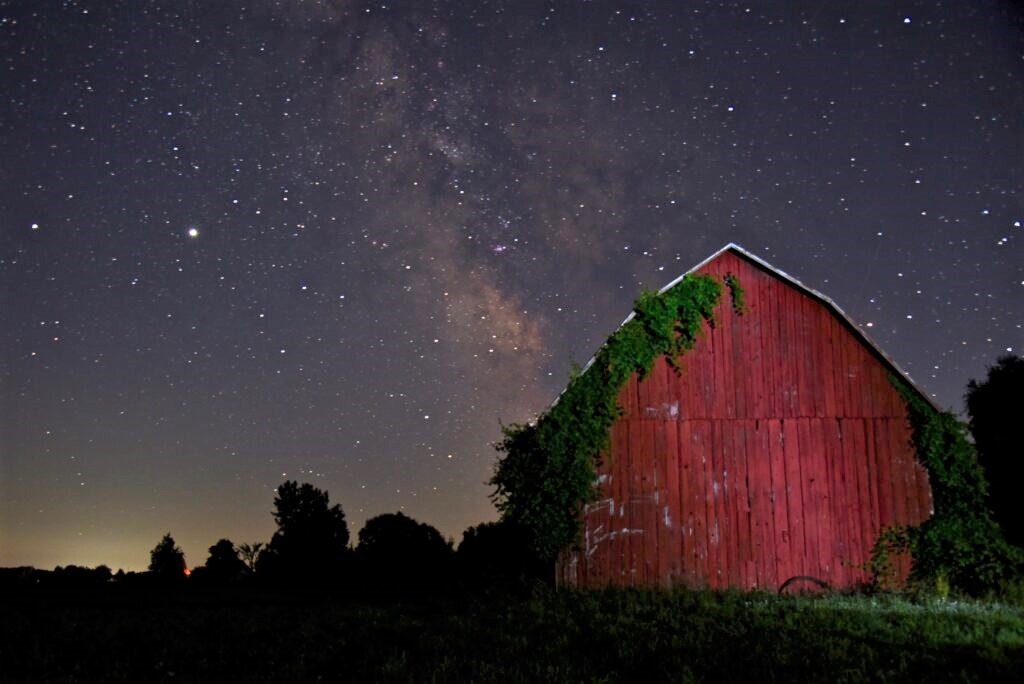Stargazing Calendar
Grab a blanket and head outside after dark.
See how many planets and stars you can find.
- Turn off the outdoor lights.
- Bring a friend.
You’ll love watching these cool night sky events in 2025!
Dark Sky Calendar 2025
- January 3 – Quadrantids Meteor Shower
- Up to 40 meteors per hour after midnight
- January 13 – Full Moon “ Spirit Moon”
- February 12 – Full Moon “ Bear Moon”
- March 14 – Full Moon “ Snow Crust Moon”
- March 14 — Total Lunar Eclipse
- Visible in North, Central and South America
- March 20 — Vernal Equinox
- Equal amount of day and night
- March 29 — Partial Solar Eclipse
- Moon cover part of Sun, looks like a bite taken out of a cookie
- Best seen from Canada
- April 13 – Full Moon “ Broken Snow Moon”
- April 22 – Lyrid Meteor Shower
- Up to 20 meteors per hour after midnight
- May 6 – Eta Aquarids Meteor Shower
- Up to 30 meteors per hour after midnight
- Produced by dust grains left behind by comet Halley
- May 12 – Full Moon “ Sucker Moon”
- June 11 – Full Moon “Blooming Moon”
- June 21 – Summer Solstice
- The North Pole of the Earth is tilted toward the Sun at its northernmost position in the sky.
- First day of summer
- Longest day of sunlight of the year
- July 10 – Full Moon “ Berry Moon”
- July 28 – Delta Aquarids Meteor Shower
- Up to 20 meteors per hour after midnight
- August 9 – Full Moon “Wild Rice Moon”
- August 12 – Perseids Meteor Shower
- Best meteor shower of the summer
- Up to 60 meteors per hour after midnight
- September 7 – Full Super Moon “Changing Leaves Moon”
- September 22 – Autumnal Equinox
- Equal amount of day and night
- October 7– Full Super Moon “ Falling Leaves Moon”
- First of three Super Moons in 2025
- Full Moon occurs same time as Perigee
- Moon may look larger and brighter.
- October 21 – Orionids Meteor Shower
- 20 meteors per hour after midnight
- Produced by dust grains left behind Comet Halley
- November 5 – Full Super Moon “Freezing Moon”
- Second of three Super Moons in 2025
- Full Moon occurs same time as Perigee
- Moon may look larger and brighter
- November 17 – Leonids Meteor Shower
- 15 meteors per hour after midnight
- December 4 – Full Super Moon “Little Spirit Moon”
- Third of three Super Moons in 2025
- Full Moon occurs same time as Perigee
- Moon may look larger and brighter
- December 13 – Geminids Meteor Shower
- Best meteor shower of the year
- 120 meteors per hour after midnight
- December 22 – Winter Solstice
- South Pole of Earth tilted toward the Sun at its southern most position
- First day of winter
- Shortest day of sunlight in the year

Photo: Meg Narwold
How Are the Full Moons Named?
Annishinaabeg, the local indigenous people, designated names of the moon to correspond with the seasonal influence.
These names are provided in quotation marks.
(Calendar updated January 2025. Source: seasky.org)
Don't just wish that Torch Lake will stay blue.
Choose a water-friendly lifestyle - make a difference!
